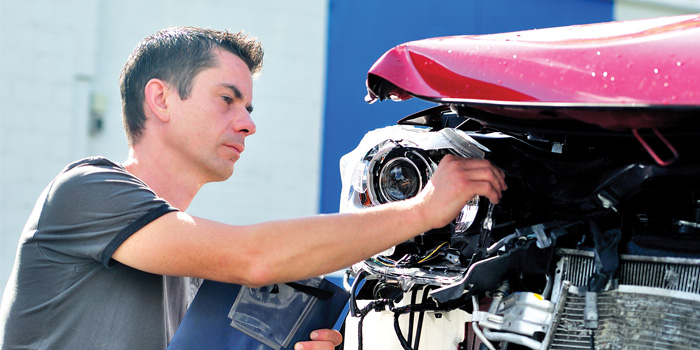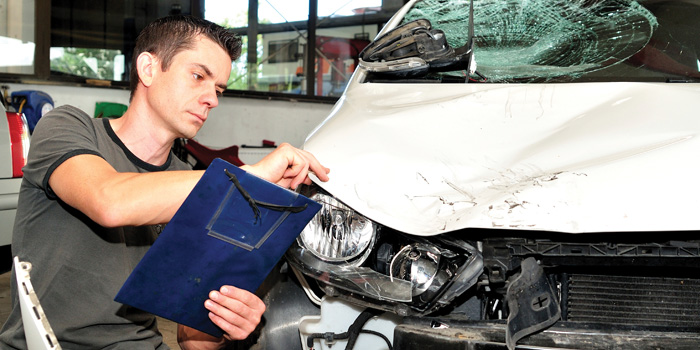When you answer the question in this article’s headline, you as the shop employee or owner had better be the one to stand up. Unfortunately, I’ve seen way too many times where this answer has caused confusion. Several shop operators and employees are under the mistaken impression that it’s up to the insurance company as to how to repair the vehicle. I get it; they’re the ones that are technically paying the bill. However, they’re not always the ones that may have the vehicle’s, or the vehicle owner’s, best interest at heart.
My intention is not to offend anyone, but at times the insurance representatives’ main focus is to repair the vehicle for as little as possible. If you’re the professional you should be, the responsibility falls on you, the shop operator, to see to it that the vehicle is repaired properly.
A Proper Repair
What does “proper” mean? I’m sure if we had a room full of people from this industry, we might come up with several different answers, so let’s start here: the safety of the passengers and the integrity of the vehicle itself should be the paramount concern.
The shop deserves to get paid to repair or replace every part, clip or consumable that’s needed to return the vehicle to its pre-loss condition. All decisions should be based from the standpoint of occupant and vehicle safety. The vehicle you’re repairing could be on the road for another 20 or more years, and you should be repairing it as if your family and your friends will be riding in it. Consumer safety should be the determining factor, not profit, metrics or anything else.
A Total?
Last month, I saw a 2013 Chevy Silverado come into the shop on the back of a flatbed. My first reaction when seeing it was, why is it here? That truck is obviously totaled. Someone chimed in and said no, that truck was already field written and it’s here for repairs. I mumbled some kind of expletive as I was in complete disbelief, since the truck I saw had heavy front-end damage, heavy damage down the entire left side, front and rear suspension damage, and a blown-out windshield. I know I’m not alone in saying that I’ve been doing this long enough to know a total when one comes in, no matter what the sheet says.
So I asked to see the estimate that came with the truck and headed out to the yard to take a look. The estimate came from a well-known insurer, one of the many that has cute commercials about discounts instead of focusing on their actual product. Here’s what I didn’t want to happen: I didn’t want someone to take this estimate, order parts and commence repairs based on the knowledge of whoever wrote it. I see myself and the operations I oversee as professional, and I wanted to judge this vehicle before we moved forward. One look at this incomplete estimate told me that whoever wrote it was surely not a professional. I viewed the truck exactly the way they did, with no lift, no teardown and no technician. All I had was their estimate, a pen, and my knowledge and experience.
I try to never become angry, but I failed in this particular instance. Whoever wrote this estimate certainly did not have occupant or public safety as their main priority, nor were they looking to be as complete or thorough as a professional in this industry should. What was their concern, in my opinion? Making themselves look good on paper. Instead of grading on aftermarket and LKQ usage, which tempts people to write for fictional items, maybe they should have been judged on accuracy and being thorough.
One pet peeve of mine is the appraiser hiding behind the excuse, “I needed a teardown.” A full and complete teardown is the only way to write an accurate estimate, but it should not be used as an excuse to be lazy. All I did was take 10 minutes and I doubled their estimate with clearly visible and unarguable damage. I also opened the hood, and all that took was reaching inside and pulling a lever. To make a long story short, I faxed in the supplement request and asked that they send someone out to write the vehicle properly as it was a total and charges were accruing. After two more visits, and us removing the bumper, the vehicle was finally totaled around three weeks later.
Here’s the point that I’m trying to make: the shop needs to be the repair expert. It’s the shop that should be invested in the latest technology and training, and have the latest repair information at their fingertips. If you’re listening to a green insurance appraiser to make decisions on how to properly repair a vehicle, you’re putting yourself in a very dangerous position. If you think that saying the insurance appraiser told you to is going to protect you in a court of law, then you’re delusional. If anything, it’s your duty to properly repair the vehicle, and people at the other side of the court will tell you that. I’m not legally trained or an attorney, but to me it’s common sense.
With that being understood, when a vehicle arrives at your shop for repairs, you need to take your role as the professional from the beginning. If you’re waiting for an appraiser before you commence repairs, you absolutely should write your own estimate. Not writing an initial estimate is a common and preventable mistake. The vehicle is there, so why wouldn’t you take the time to research and write for proper repairs. This is also a great time to research ALLDATA for the approved repair procedures.
Art of Negotiation
When I was a kid and first got into this business, in the days before direct repairs, there was a certain art of negotiation between the shop and the appraiser. There were no hit- and-run estimates where the appraisers snapped some photos and took off, promising to fax them at some point. Whether you’re a direct repair shop or not, there will still be out-of-network claims where a staff appraiser comes out to write it. I would suggest that you thoroughly inspect the vehicle while you’re waiting, prepare a proper estimate and give it to that appraiser. I would also tell that appraiser to print his or her estimate when they’re ready so that you can review it with them. Finally, review that estimate with the appraiser line by line so that you both can be in agreement with what needs to be done with that vehicle.
Summary
Invest all of the knowledge and training in yourself that you possibly can. Be the expert and the professional you need to be. Don’t leave your future in someone else’s hands, and remember: occupant and vehicle safety should be the main concern.















